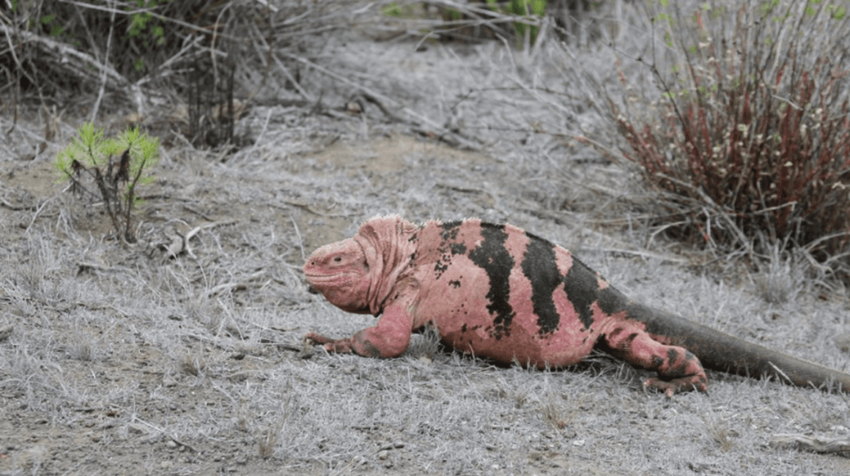
The Mystery of the Pink Iguanas
The Galapagos Islands are known around the world for the unique flora and fauna that are found in this isolated archipelago. These volcanic islands are located at the convergence of four oceanic currents. These extraordinary conditions have created an environment that hosts multiple climate zones and conditions that became a cradle of development for many distinctive animal species. Known as a living laboratory, the Galapagos Islands are home to endemic animal species found nowhere else on earth. One of the most recent species to be discovered in the Galapagos Islands is the Galapagos Pink Land Iguana (Conolophus marthae). The Pink Land Iguanas were first spotted by Galapagos National Park wardens in 1986. In 2009, it was determined these elusive Pink Land Iguanas are a separate species from all other land iguanas.
What is known about the Galapagos Pink Land Iguanas:
Why are these iguanas pink? These iguanas are pink with black spots and stripes. The reason they appear pink is due to the lack of pigment in the skin that appears to be pink. The circulating blood under their skin gives the iguanas their pink color.
Are Pink Land Iguanas a new species? When the Pink Land Iguana was first spotted in 1986 it was thought to be just an oddity. After genetic studies were done, it was revealed that the genetic divergence for the Pink Land Iguanas happened 5.7 million years ago. This makes the Pink Land Iguanas one of the oldest endemic Galapagos species.
Are they like other land iguanas? The Pink Land Iguanas have a similar physical structure to Galapagos Land Iguanas. The short head and strong back legs with sharp claws are characteristic of Galapagos land iguanas.
What do they eat? In the limited observations made, they appear to be primarily herbivores. They have been seen eating the pads and fruit from prickly pear.
Where do Galapagos Pink Land Iguanas live? The only location they have been observed is in an area that is 25 sq km on the slopes of the Wolf Volcano in northern Isabela. The nests & borrows have not yet been found.
How many Pink Land Iguanas are there? A census was conducted and approximately 200 individuals were counted. From this census, a good estimation would be a population of about 300.
What needs to be discovered:
There are many things not known about the Galapagos Pink Land Iguana. It is important that research is done to find out more important information to ensure the species thrives. Here are some important questions that need to be answered.
Are introduced species threatening the survival of the Galapagos Pink Land Iguana? Rats and other introduced species can disrupt barrows and nests of the Pink Land Iguanas. This can be mean viable eggs are eaten or disturbed and are no longer viable. It isn’t know all the potential threats rats and feral animals are creating for the Pink Land Iguanas. These can be cause serious threats.
What do Pink Iguana hatchlings look like? It isn’t known yet. No juveniles have been observed.
Is there a viable breeding population? It isn’t known yet. More observation is needed.
Are the neighboring Land Iguanas encroaching on the Pink Land Iguana’s territory and threatening their survival? The two species may coexist or one could be encroaching on the territory of the other creating a threat of survival.
Where do they nest? It isn’t known yet. In the challenging terrain, no nests have been discovered.
Why haven’t juveniles been spotted? Not spotting juveniles could indicate there are serious threats to successful reproduction or they just have not been found. Successful reproduction is a key factor in the survival of the species.
Are there other threats to the Galapagos Pink Land Iguana? A volcanic eruption is another threat to the survival of the Pink Land Iguana. The more that is learned about the behavior the more successful an emergency plan would be if there was an eruption.
How you can help
There are so many questions that need to be answered to protect this newly discovered species to ensure their survival. Much more information needs to be gathered. How can more be learned? A consistent observation plan needs to be carried out. The area where the Pink Iguanas live is uninhabited rough terrain on the Wolf volcano. With current technology, part of the observation is being done using video cameras placed in the Pink Land Iguana’s territory. In conjunction with regularly scheduled fieldwork, in this remote and challenging location, to make additional observations to support this important fact-finding mission. From the data gathered, fact-based conservation plans can be created and implemented.
The first step is gathering the data. If you would like to support this important project to conserve the Galapagos Pink Land Iguana you can make a donation to the Galapagos Conservancy. Quality conservation programs are vital to the Galapagos wildlife. At Torre Mar Galapagos Boutique Suites, we support science-based conservation programs like this. Support this important work of the Galapagos National Park wildlife management and be part of the team that solves the mystery of the Pink Iguanas. #galapagos #galapagosislands #pinkiguanas #galapagosconservancy #wildlifeconservation
